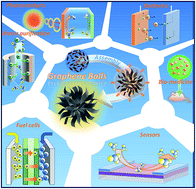Three-dimensional graphene-based spheres and crumpled balls: micro- and nano-structures, synthesis strategies, properties and applications
Abstract
In recent years, three-dimensional (3D) graphene-based architectures have received considerable research attention, comprising both fundamental studies and investigations of potential applications by a number of researchers who have performed exhaustive examinations of the versatile and astonishing properties of these 3D materials, such as their large surface area, excellent electronic and thermal conductivity, superb chemical, thermal, and electrochemical stability, enhanced active material per area, fast ion and electron transportation, superior mechanical strength, and high flexibility. In this critical review, we comprehensively address the primary advancements in 3D spherical and crumpled-ball graphene-based material synthesis techniques. In addition, we provide an overview of their applications in various types of batteries and supercapacitors, as well as in fuel cells, sensors, catalysts, solar cells, and so on, with the aim of discussing these materials' wide range of interesting properties compared with other types of graphene-based structures. Statistical information based on the available literature, which indicates that energy storage devices are more noteworthy research topics than other applications, is also provided. The discussion is concluded with some personal insights into future research direction opportunities, based on the current status of this field. We believe that this review provides critical insights that will further the understanding of the significance of graphene-based spheres and crumpled balls, and, hence, will aid in the further investigation and enhancement of these high-performance nanomaterials from both an interpretative technological and scientific perspective.


 Please wait while we load your content...
Please wait while we load your content...